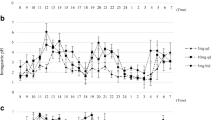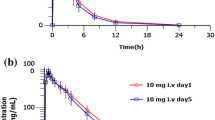Abstract
To achieve more potent and long-lasting acid suppression, omeprazole was administered for 7 days in 5 regimens: 10, 20, and 40 mg once daily (od), and 10 and 20 mg twice daily (bid), in 7 healthy Helicobacter pylori-negative CYP2C19 homozygous extensive metabolizers, and intragastric pH was continuously measured. The median intragastric pH and percent time pH > 4.0 for 24 hours increased dose dependently with 10, 20, and 40 mg od. Ten and 20 mg bid wre comparable to 20 and 40 mg od, respectively. Concerning percent time pH > 4.0 in the nighttime (20:00–8:00 hours), 20 mg bid was significantly superior to 40 mg od (P < .05). In 4 of the 5 regimens, all 7 subjects had nocturnal acid breakthrough, whereas with 20 mg bid it occurred in only 3. We concluded that, considering nighttime acid suppression, omeprazole 20 mg bid had the strongest effect.




Similar content being viewed by others
References
Sachs G, Wallmark B (1989) The gastric H+,K+-ATPase: the site of action of omeprazole. Scand J Gastroenterol (Suppl) 166:3–11
Sachs G, Shin JM, Briving C, Wallmark B, Hersey S (1995) The pharmacology of the gastric acid pump: the H+,K+ ATPase. Annu Rev Pharmacol Toxicol 35:277–305
Bate CM, Keeling PW, O’Morain C, Wilkinson SP, Foster DN, Mountford RA, Temperley JM, Harvey RF, Thompson DG, Davis M, Forgacs IC, Bassett KS, Richardson PDI (1990) Comparison of omeprazole and cimetidine in reflux oesophagitis: symptomatic, endoscopic, and histological evaluations. Gut 31:968–972
Porro GB, Pace F, Peracchia A, Bonavina L, Vigneri S, Scialabba A, Franceschi M (1992) Short-term treatment of refractory reflux esophagitis with different doses of omeprazole or ranitidine. J Clin Gastroenterol 15:192–198
Dent J, Yeomans ND, Mackinnon M, Reed W, Narielvala FM, Hetzel DJ, Solcia E, Shearman DJ (1994) Omeprazole v ranitidine for prevention of relapse in reflux oesophagitis. A controlled double blind trial of their efficacy and safety. Gut 35:590–598
Hallerback B, Unge P, Carling L, Edwin B, Glise H, Havu N, Lyrenas E, Lundberg K (1994) Omeprazole or ranitidine in long-term treatment of reflux esophagitis. The Scandinavian Clinics for United Research Group. Gastroenterology 107:1305–1311
Vigneri S, Termini R, Leandro G, Badalamenti S, Pantalena M, Savarino V, Di Mario F, Battaglia G, Mela GS, Pilotto A, Plebani M, Davi G (1995) A comparison of five maintenance therapies for reflux esophagitis. N Engl J Med 333:1106–1110
Robertson D, Aldersley M, Shepherd H, Smith CL (1987) Patterns of acid reflux in complicated oesophagitis. Gut 28:1484–1488
Adachi K, Fujishiro H, Katsube T, Yuki M, Ono M, Kawamura A, Rumi MA, Watanabe M, Kinoshita Y (2001) Predominant nocturnal acid reflux in patients with Los Angeles grade C and D reflux esophagitis. J Gastroenterol Hepatol 16:1191–1196
Katz PO (2005) Review article: putting immediate-release proton-pump inhibitors into clinical practice—improving nocturnal acid control and avoiding the possible complications of excessive acid exposure. Aliment Pharmacol Ther 22(Suppl 3):31–38
Peghini PL, Katz PO, Bracy NA, Castell DO (1998) Nocturnal recovery of gastric acid secretion with twice-daily dosing of proton pump inhibitors. Am J Gastroenterol 93:763–767
Peghini PL, Katz PO, Castell DO (1998) Ranitidine controls nocturnal gastric acid breakthrough on omeprazole: a controlled study in normal subjects. Gastroenterology 115:1335–1339
Ohara S, Kimpara T, Sekine H, Moriyama S, Kato K, Nakayama Y, Saito N, Sugiyama K, Asaki S, Toyota T (1995) Comparison of acid-inhibitory effect of omeprazole in before-breakfast dosing and after-breakfast dosing [in Japanese]. Jpn Pharmacol Ther 23:879–885
Kuo B, Castell DO (1996) Optimal dosing of omeprazole 40 mg daily: effects on gastric and esophageal pH and serum gastrin in healthy controls. Am J Gastroenterol 91:1532–1538
Hatlebakk JG, Katz PO, Kuo B, Castell DO (1998) Nocturnal gastric acidity and acid breakthrough on different regimens of omeprazole 40 mg daily. Aliment Pharmacol Ther 12:1235–1240
Orr WC, Harnish MJ (2003) The efficacy of omeprazole twice daily with supplemental H2 blockade at bedtime in the suppression of nocturnal oesophageal and gastric acidity. Aliment Pharmacol Ther 17:1553–1558
Wilder-Smith C, Halter F, Ernst T, Gennoni M, Zeyen B, Varga L, Roehmel JJ, Merki HS (1990) Loss of acid suppression during dosing with H2-receptor antagonists. Aliment Pharmacol Ther 4(Suppl 1):15–27
Nwokolo CU, Smith JT, Gavey C, Sawyerr A, Pounder RE (1990) Tolerance during 29 days of conventional dosing with cimetidine, nizatidine, famotidine or ranitidine. Aliment Pharmacol Ther 4(Suppl 1):29–45
Smith JT, Gavey C, Nwokolo CU, Pounder RE (1990) Tolerance during 8 days of high-dose H2-blockade: placebo-controlled studies of 24-hour acidity and gastrin. Aliment Pharmacol Ther 4(Suppl 1):47–63
Rogers MJ, Holmfield JH, Primrose JN, Johnston D (1990) The effects of 15 days of dosing with placebo, sufotidine 600 mg nocte or sufotidine 600 mg twice daily upon 24-hour intragastric acidity and 24-hour plasma gastrin. Aliment Pharmacol Ther 4(Suppl 1):65–74
Nwokolo CU, Sawyerr A, Smith JT, Pounder RE (1990) Intravenous pentagastrin can induce the illusion of ‘tolerance’ to a single dose of an H2-blocker in man. Aliment Pharmacol Ther 4(Suppl 1):75–83
Wilder-Smith CH, Ernst T, Gennoni M, Zeyen B, Halter F, Merki HS (1990) Tolerance to oral H2-receptor antagonists. Dig Dis Sci 35:976–983
Furuta T, Ohashi K, Kosuge K, Zhao XJ, Takashima M, Kimura M, Nishimoto M, Hanai H, Kaneko E, Ishizaki T (1999) CYP2C19 genotype status and effect of omeprazole on intragastric pH in humans. Clin Pharmacol Ther 65:552–561
Shimatani T, Inoue M, Kuroiwa T, Horikawa Y, Mieno H, Nakamura M (2003) Effect of omeprazole 10 mg on intragastric pH in three different CYP2C19 genotypes, compared with omeprazole 20 mg and lafutidine 20 mg, a new H2-receptor antagonist. Aliment Pharmacol Ther 18:1149–1157
Furuta T, Shirai N, Watanabe F, Honda S, Takeuchi K, Iida T, Sato Y, Kajimura M, Futami H, Takayanagi S, Yamada M, Ohashi K, Ishizaki T, Hanai H (2002) Effect of cytochrome P4502C19 genotypic differences on cure rates for gastroesophageal reflux disease by lansoprazole. Clin Pharmacol Ther 72:453–460
Kawamura M, Ohara S, Koike T, Iijima K, Suzuki J, Kayaba S, Noguchi K, Hamada S, Noguchi M, Shimosegawa T; Study Group of GERD (2003) The effects of lansoprazole on erosive reflux oesophagitis are influenced by CYP2C19 polymorphism. Aliment Pharmacol Ther 17:965–973
Furuta T, Shirai N, Takashima M, Xiao F, Hanai H, Sugimura H, Ohashi K, Ishizaki T, Kaneko E (2001) Effect of genotypic differences in CYP2C19 on cure rates for Helicobacter pylori infection by triple therapy with a proton pump inhibitor, amoxicillin, and clarithromycin. Clin Pharmacol Ther 69:158–168
Miki I, Aoyama N, Sakai T, Shirasaka D, Wambura CM, Maekawa S, Kuroda K, Tamura T, Kita T, Sakaeda T, Okumura K, Kasuga M (2003) Impact of clarithromycin resistance and CYP2C19 genetic polymorphism on treatment efficacy of Helicobacter pylori infection with lansoprazole- or rabeprazole-based triple therapy in Japan. Eur J Gastroenterol Hepatol 15:27–33
de Morais SM, Wilkinson GR, Blaisdell J, Meyer UA, Nakamura K, Goldstein JA (1994) Identification of a new genetic defect responsible for the polymorphism of (S)-mephenytoin metabolism in Japanese. Mol Pharmacol 46:594–598
de Morais SM, Wilkinson GR, Blaisdell J, Nakamura K, Meyer UA, Goldstein JA (1994) The major genetic defect responsible for the polymorphism of S-mephenytoin metabolism in humans. J Biol Chem 269:15419–15422
Kubota T, Chiba K, Ishizaki T (1996) Genotyping of S-mephenytoin 4’-hydroxylation in an extended Japanese population. Clin Pharmacol Ther 60:661–666
Lind T, Cederberg C, Ekenved G, Haglund U, Olbe L (1983) Effect of omeprazole—a gastric proton pump inhibitor—on pentagastrin stimulated acid secretion in man. Gut 24:270–276
Naesdal J, Bodemar G, Walan A (1984) Effect of omeprazole, a substituted benzimidazole, on 24-h intragastric acidity in patients with peptic ulcer disease. Scand J Gastroenterol 19:916–922
Howden CW, Forrest JA, Reid JL (1984) Effects of single and repeated doses of omeprazole on gastric acid and pepsin secretion in man. Gut 25:707–710
Olbe L, Cederberg C, Lind T, Olausson M (1989) Effect of omeprazole on gastric acid secretion and plasma gastrin. J Gastroenterol Hepatol 4(Suppl 2):19–25
Nakashima M, Kanamaru M, Hashimoto H, Takiguchi Y, Mizuno A, Kajiho H, Oka T, Matsuda Y (1988) Phase I study of omeprazole-single-dose and multiple-dose studies [in Japanese]. Jpn J Clin Pharmacol Ther 19:667–679
Andersson T, Andren K, Cederberg C, Heggelund A, Lundborg P, Rohss K (1990) Bioavailability of omeprazole as enteric coated (EC) granules in conjunction with food on the first and seven days of treatment. Drug Invest 2:184–188
Howden CW (1991) Clinical pharmacology of omeprazole. Clin Pharmacokinet 20:38–49
Stedman CA, Barclay ML (2000) Comparison of the pharmacokinetics, acid suppression and efficacy of proton pump inhibitors. Aliment Pharmacol Ther 14:963–978
Author information
Authors and Affiliations
Rights and permissions
About this article
Cite this article
Shimatani, T., Kuroiwa, T., Moriwaki, M. et al. Acid-Suppressive Effects of Various Regimens of Omeprazole in Helicobacter pylori-Negative CYP2C19 Homozygous Extensive Metabolizers: Which Regimen Has the Strongest Effect?. Dig Dis Sci 52, 2826–2832 (2007). https://doi.org/10.1007/s10620-006-9643-x
Received:
Accepted:
Published:
Issue Date:
DOI: https://doi.org/10.1007/s10620-006-9643-x




